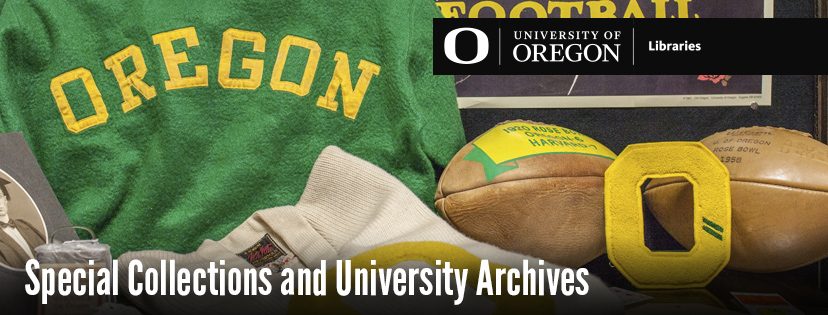New Acquisition: David C. Herrin Photograph: Wanbdi Wanapeya (Eagle That Scares)

Photograph of Wanbdi Wanapeya (Eagle That Scares), member of the Lower Yanktonai, photographed by David C. Herrin. Recently acquired by University of Oregon Special Collections and University Archives.
University of Oregon Special Collections and University Archives (SCUA) recently acquired a rare photograph of Chief Eagle That Scares of the Lower Yanktonai, photographed by David C. Herrin of Portland, Oregon (1899-1901 residency). In the dialect of the Lower Yanktonai, Eagle That Scares translates to the Native name, Wanbdi Wanapeya. The Lower Yanktonai, or “Little End Village,” were additionally referred to as Hunkpatina. As a smaller constituent of the larger Sioux Confederation originating in the lands of Minnesota, the Lower Yanktonai experienced numerous migrations and forced transplantations. In the late nineteenth century, the Lower Yanktonai would come to reside largely in the Standing Rock reservation of North and South Dakota, the Crow Creek reservation of South Dakota, the Fork Peck reservation of Montana, the Spirit Lake reservation of North Dakota, and a smaller population of Yanktonai dispersed in Canada. In their migrations, the Lower Yanktonai supported Sioux Confederation tribes materially, in intertribal relations, and in governmental matters, including negotiating federal policy with officials. All were actions that effected a powerful confederacy of tribes diverging in interest and geographic location (Galler, 2008).
The photograph of Eagle That Scares was the work of photographer David C. Herrin, or D. C. Herrin. David C. Herrin and his wife, Margaret, who was also a renowned photographer, operated several photography studios in their tenure as photographers. Most notably, the Herrins owned a photography studio in The Dalles from 1892-1898, and in 1899 transplanted to Portland, Oregon, to open a photography studio in cooperation with famed photographer Frank G. Abell (Old Oregon, n.d.). Abell-Herrin Co. operated approximately around the years of 1899-1901. David C. Herrin was also quite active in the Ancient Order of United Workmen (AOUW) as grand official instructor (Historic Photo Archive, n.d.). The AOUW was established post-Civil War as a “fraternal benefit society” providing insurance, including death benefits, to select members, mainly white (Wikipedia, 2020).
In 1893, David C. Herrin released a collection of scenic photographs, most prominently featuring the Columbia River and “Dalles people,” quoted from the Dalles Times Mountaineer, 10 October 1983 (Historic Photo Archive, n.d.). The photograph of Eagle That Scares is one of a series of fifty-four photographs of Native Americans photographed by David C. Herrin. The obverse of the photo of Eagle That Scares lists the names of the Native Americans featured in the series, as well as artist name and location. The photo is an albumen print on a cabinet card.
Sources
Galler, R. W., Jr. (2008). Sustaining the Sioux Confederation: Yanktonai initiatives and influence on the Northern Plains, 1680-1880. Western Historical Quarterly, 39(4), 467-490. https://www.jstor.org/stable/25443780
Historic Photo Archive. (n.d.). Herrin, David C. (Ashland, Medford, Portland, The Dalles). http://historicphotoarchive.com/oregon-photographers-online-edition/herrin-david-c-ashland-medford-portland-the-dalles/
Old Oregon. (n.d.). David C. Herrin. https://www.oldoregonphotos.com/photographers/dcherrin.html
Wikipedia. (2020, June 4). Ancient Order of United Workmen. https://en.wikipedia.org/wiki/Ancient_Order_of_United_Workmen
— Written by Alexandra Mueller, Special Projects Archivist

